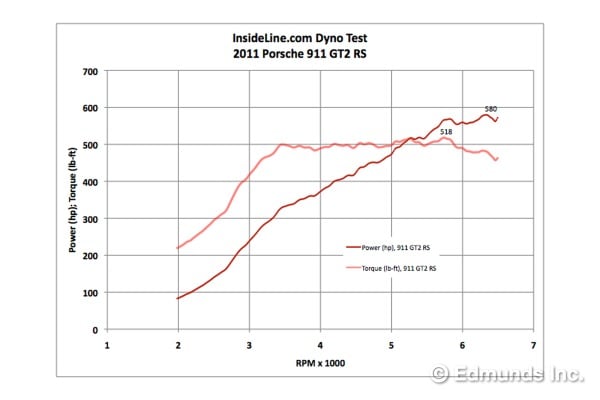
Simply put, it was a powerful day. First we ran the 2012 Lexus LFA on the rollers of the Dynojet 248 chassis dyno, and immediately following it was the 2011 Porsche 911 GT2 RS. Yes, that RS, the limited-production powerhouse of power with power.
Each car is indeed the most horsepower-laden production vehicle ever turned out by their respective automaker. For Porsche, that's saying a lot. For Toyota, well, it says not quite as much.
You've seen the LFA's dyno result. So how did Porsche's latest turbopanzer fare? Hit the jump.
What's that? The humdrum, rear-drive, turbocharged Porsche 911 GT2 is weaksauce; a little too soft in the middle for you? Here's your solution, Clanky McBrassballs -- the GT2 RS subtracts weight and adds power (plus a hefty sum to the window sticker) to the tune of 620 horsepower and 516 lb-ft as measured at the flywheel.
Think of the GT2 RS as the swan song for not only the 997-based 911 but also the "Metzger" engine, the motorsports version of the Porsche flat-six. Today, the Metzger engine is found only in GT3/GT3 RS/GT2 and GT2 RS versions of the 911. And while Porsche cranks out special- and limited-edition versions of the 997 at an ever-increasing pace as the sun sets on this generation of 911, the GT2 RS will go down as the most powerful production Metzger of them all.

Honest, all the Porsche dorks swear up and down that there's an engine in the trunk.
The Metzger engine is an entirely different architecture than that of the Boxster/Cayman and garden-variety 911s (including the Turbo), and it displaces "only" 3.6 liters and employs conventional port fuel injection to the Turbo's 3.8 liters and direct injection. Yet when Porsche builds their hardest-core models, they consistently tap the Metzger engine for duty.
It's difficult to argue with this:

That's 580 horsepower and 518 lb-ft as measured at the wheels on California's "premium" 91 octane. Yeah, all the ponies are in the stable. And how. Torque hovers right around 500 lb-ft from 3500 to nearly 6000 rpm and barely tapers off as it runs into the fuel cut, resulting in a crushingly wide and flexible powerband.
However, since nitpicking is what I do, I expected the boost to rise faster than it did (see the ramp in torque up to 3500 rpm) as the GT2 RS has fancy variable-nozzle turbos. To be fair, the boost (and torque) will rise sooner in a taller gear, but 140 mph at the top of fourth puts plenty enough heat in the tires on a dyno, thank you.
The lack of rotating inertia is noticeable even on the dyno. This car forces you to really be on your game when you shift, else the revs rise or fall too much and you feel like a tool. Beyond that, this engine is a total pussycat -- you can easily creep away from a stoplight or plunk around at low revs without a hiccup in the power delivery, and the clutch is substantial but totally progressive.
Its engine note isn't much to write home about. There's a flat, pissed-off roar as the GT2 RS absolutely pulverizes the rollers, and that's it. It's not as dumpy-sounding as a Viper, but it definitely doesn't tingle the spine the way Porsche's normally aspirated flat-sixes do. Then again, normally aspirated engines can't produce the torque that a turbocharged engine can. Life is such a series of tradeoffs.

This car points up the importance of speed in making power. Namely, the dyno fan situated at the nose of the car is too directional to supply adequate air to the intercooler ducts atop the rear fenders -- on one run the car lost 70 horsepower as it tried to reconcile the high manifold temperatures with the ambient air temperature. Figuring a small child was inadvertedly jammed in each intercooler duct, it dialed back boost and throttle as a self-preservation mechanism.
Once I pointed little squirrel-cage fans into the intercooler ducts, all the power returned, and consistently so. Out in the wild it'll have Mother Nature supplying literally all the air in the world to the intercoolers. Just keep those damned rugrats from cramming themselves into the rear fenders and you'll be all set.
As for our mega-power day on the dyno, here's how the 911 GT2 RS stacks up to the Lexus LFA:

Although the LFA revs some 40% higher than the GT2 RS, in fourth gear both cars reach their respective rev limits at 140 mph. It turns out the LFA's gearing is similarly shorter than the Porsche's. How's that for two completely different means arriving at the same end, speed-wise?
